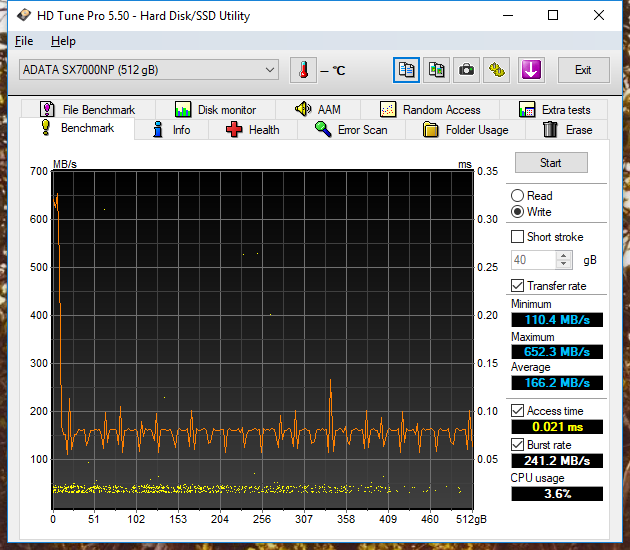HDTUNE
HD Tune is a Hard Disk Utility with many functions from error checking, health testing (S.M.A.R.T.), and of course benchmarking. To build upon our real world write test we also looked to see where the write speeds leveled off to by using HD Tune Pro. If SLC caching is being utilized, this test will typically show it.
Finally, taking a look at how it performs under HDTune’s full write test, we can see that there is most definitely an SLC cache being used. After a few GB of data, the write performance drops down to about 150MB/s for the majority of the test, just like the Intel 600P.
REPORT ANALYSIS AND FINAL THOUGHTS
In today’s rounds of testing the ADATA XPG Gammix S10 performed as promised. It delivered sequential read and write speeds of up to 1830MB/s and 860MB/s, respectively, and also exceeded it’s random IOPS ratings of 130K/140K IOPS read/write in our 4 corners testing. We saw that during extended write workloads that the ADATA XPG Gammix S10’s write performance can degrade, just like the Intel 600P’s does. During our 30GB transfer, it averaged just under 340MB/s write and in HDTune it averaged about 150MB/s once the SLC cache ran out.
Furthermore, during a standard run of PCMark 8’s storage benchmark, the ADATA XPG Gammix S10 delivered a score of 5025 points and averaged 351MB/s bandwidth, making it better than the Intel 600P, but not by much. During the extended run, it, again, delivered better performance than the Intel 600P, especially under the degrade and steady state phases, but overall, its performance is lower than most other NVMe SSDs.
Finally, when looking at the Gammix S10’s power consumption we can see that because of its slower write speed after the SLC cache fills, it ranks in at second to last place in terms of write efficiency. Idle power consumption is better than most other NVMe SSDs we tested, but improvements could be made.
FINAL THOUGHTS
In the beginning of the review, we set to see out validation on a statement made by ADATA about the XPG Gammix S10. They said that it was “built for professionals.” But, is this really the case? We think after looking through the data we can finally come to a conclusion on that. In our opinion, it is not.
It seems to us that while the XPG Gammix S10 was able to outperform the Intel 600P, it was still just barely faster than Samsung’s 3-year-old 850 EVO SATA SSD. With performance results that are within throwing distance of what high-end SATA SSDs are capable of, it looks like the XPG Gammix S10 will have to bank on overall value to win customers over.
Luckily for ADATA, this shouldn’t be hard going by the fact that the Gammix S10’s incredibly low street price of $164.99 for the 512GB model marks it well below any of its direct competition. Also, it’s only $15 more than the Samsung 850 EVO 500GB and is capable of outperforming it during most light workloads and can dish out reads at up to 1.8GB/s. On top of that, you don’t need any SATA data and power cables for it like you do with a normal 2.5″ SSD and it looks very stylish with its red and black heatsink. And let’s not forget that ADATA backs this SSD with a 5-year warranty, gives you access to Acronis True Image for cloning, and there is an SSD toolbox to play with too!
Now the real question is, is this SSD is worth your buck at the end of the day? While we don’t feel that it is an ideal candidate for professionals, we feel that it is more than adequate for most gamers, overclockers, and entry-level media creators. Sure, it is not the fastest NVMe SSD out, but for the price, it should sway quite a few of those in the market away from SATA based SSDs. The ADATA XPG Gammix S10 will also give you a bit more bang for your buck than the Intel 600P and it will definitely look better doing it too. It’s a great value entry-level M.2 NVMe SSD.
If you are interested in making this your next purchase, be sure to…
 The SSD Review The Worlds Dedicated SSD Education and Review Resource |
The SSD Review The Worlds Dedicated SSD Education and Review Resource | 


Mr. Webster, thanks for the review as usual.
Man oh man, these are some rough benchmarks. A solid notch above the worst drive. In the 30GB transfer test it abysmally gives way to 850 EVO? I certainly agree with you, there is no way this is a device for “professionals”.